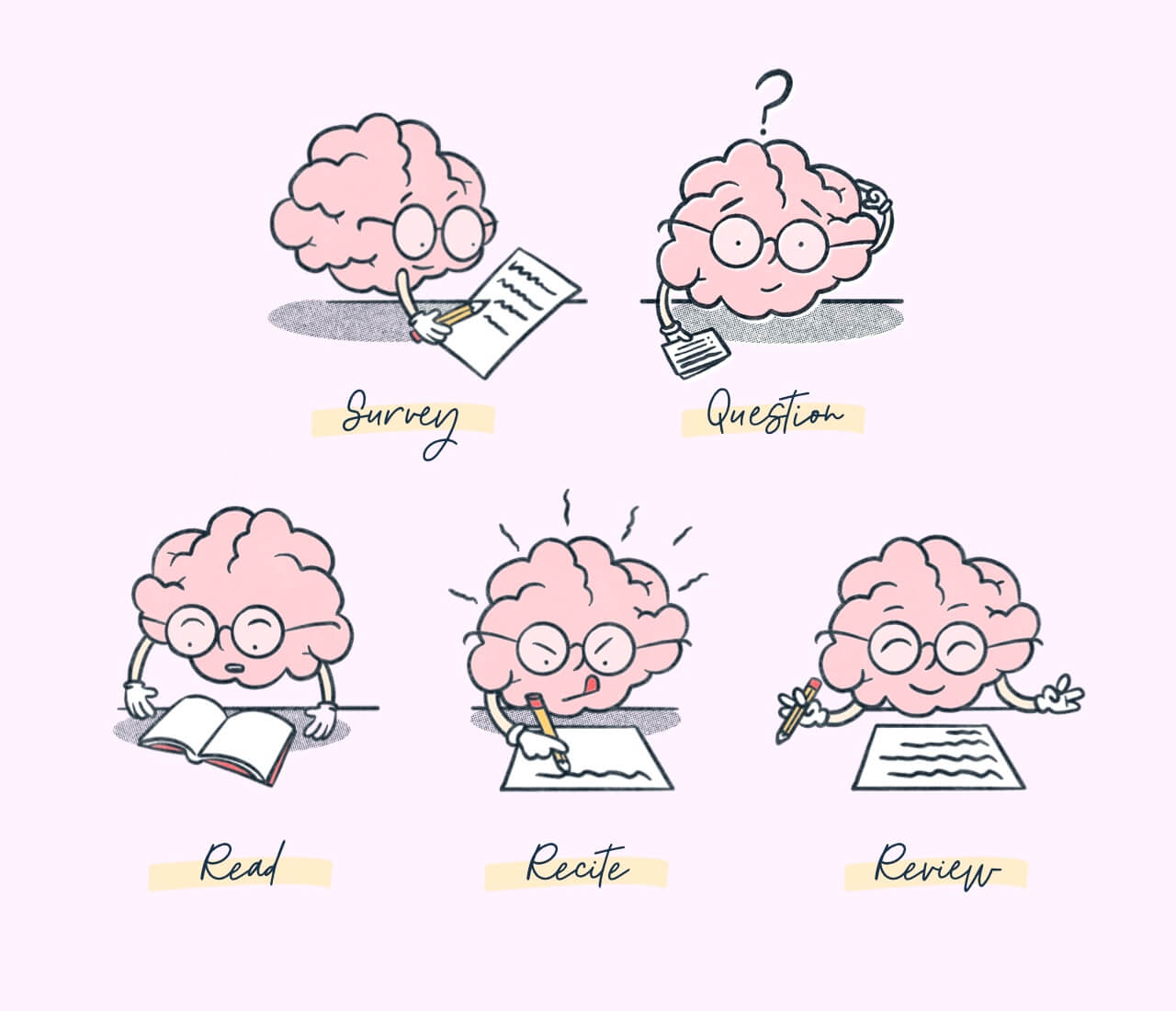Here’s a hot take: textbooks aren’t always the most interesting or accessible to read.
It doesn’t matter if you’re super interested in the topic. Textbooks aren’t typically written to be deeply engaging. They are written to be informative. Granted, there are a few outliers, but can you really say with certainty that you enjoy reading textbooks?
Regardless of the lack of joy textbooks spark, they are a necessity. If you’ve never had to read a textbook, consider yourself a lucky unicorn. For everyone else, we would like to introduce a study method you might not have heard of — theSQ3R.
SQ3R what?
The SQ3R method was first introduced in 1946 by American educational psychologist Francis P. Robinson in his book Effective Study. The goal of this method was to promote enhanced learning of reading material. Although SQ3R can be used for any reading, it is commonly applied to textbooks.
You’ve probably figured out that SQ3R is an acronym. Here’s what SQ3R stands for:
- Survey
- Question
- Read
- Recite
- Review
These steps are meant to help you actively engage with the reading and extract as much information as possible. You need to commit to the bit for it to be effective.
How to put SQ3R into practice
The first few times you try out the SQ3R method, it might feel funky, but give it some time. It’s important to follow the steps in the correct order to get this method to work.
1.Survey.
You want to start by surveying the reading to get a synopsis of the points and orient yourself to what information is essential. This is not where you read every word and sentence.
The point of the survey step is to rapidly look over chapter titles, headings, bolded texts, and anything else that might indicate what main points are being made. Ideally, this should take only one to three minutes.
2.Question.
Question, in this instance, refers to turning the points you found during the survey stage into questions that the rest of the text will answer. By doing this, you’re helping your mind engage and concentrate on the information you have to learn. When your mind is actively searching for answers to the questions you posed, you’re more likely to participate in learning actively.

The questions you develop should be demanding enough that you must read to find the answer. This means avoiding questions that have simple answers such as yes/no or true/false.
3.Read
While the name might make you want to say duh, there is a little more nuance than you’d think. When you’re rereading the material, you are doing so to answer the questions you had previously thought up. This isn’t the time to just aimlessly read the text. Instead, you’re actively participating.
There is an objective and a goal you are trying to achieve. Reading is going to help you fill in the information around the questions you’ve previously been building.
4.Recite
Don’t let the word recite freak you out. Recite doesn’t mean reciting the information while in a very public place causing people to look at you or think you’re possessed. Fellow shy people, we got you.
Think of reciting as memory or information recall. Do this without looking at the text and use your own words or examples. Using your own words ensures that you understand the material before moving on to a new section, not too dissimilar to the Feynman Technique.
If you can’t answer your questions, don’t sweat it. Glance over the passages again, then give it another shot.
This stage is an excellent opportunity to make brief notes that you can expand on. By incorporating writing, you’re “forcing” yourself to verbalize and restructure the information into your own words. You can also use your notes later to review the information for tests.
Keep these three things in mind when you’re on the Recite step:
- Don’t write notes until the whole section has been read
- Do write notes from memory
- Don’t look at the text
- Do write the notes in your own words and keep it brief
5.Review
It is time to review the hard work you put into the previous steps. Look over your notes to make sure they make sense and include the most important information from the text. Practicing this review and recall will help you figure out what you know as well as what you need to study.
You should have a solid understanding of the material of each section before you move on to the next.
Why it’s worth trying
Does SQ3R work? For a lot of people, yes. In a 2019 study, Improving Students’ Reading Comprehension Through SQ3R Technique, researchers measured reading comprehension in a before and after SQ3R treatment scenario. The students who were taught and asked to employ the SQ3R method improved their reading comprehension scores by a significant amount.
SQ3R encourages you to actively engage with the reading material instead of just reading. You take the reins and navigate the text in a way that allows you to get the most out of it.
Beyond that, the benefits you can gain from using the SQ3R method are:
- Figure out what you’re expected to learn from the text
- Learn how to comprehend the ideas rapidly
- Develop ways to remember the information that works for you
- Create a method to review large amounts of information efficiently for exams
Next time you have some extra time and a textbook you’re not looking forward to reading, try out this study method. Who knows, maybe this will be your new favorite study method, or at least it will help you review past readings for your next exam.


 learning science
learning science